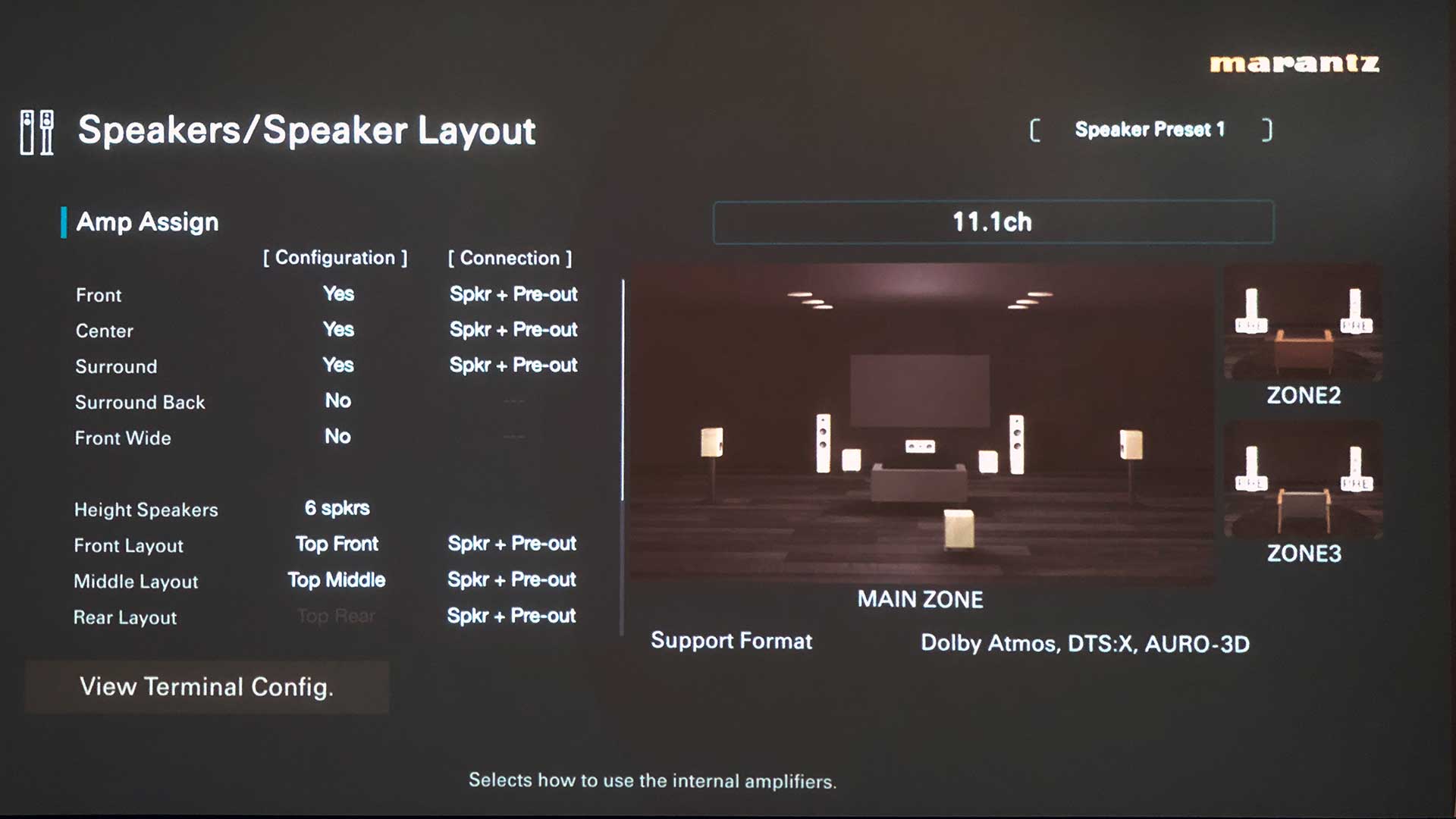Sound+Image Verdict
More power as well as more channels than any lower model, along with pretty much exhaustive socketry (bar USB-B), full streaming and more than full multiroom.
Pros
- +
11 channels of high-quality power and 13 of processing
- +
Full processing for Atmos, DTS: X and Auro-3D
- +
Lots of calibration options
- +
Well-stocked with inputs and HEOS streaming
Cons
- -
No USB-B
- -
No FM or DAB+ tuners (despite what is says online)
- -
Perhaps too many calibration options
Why you can trust What Hi-Fi?
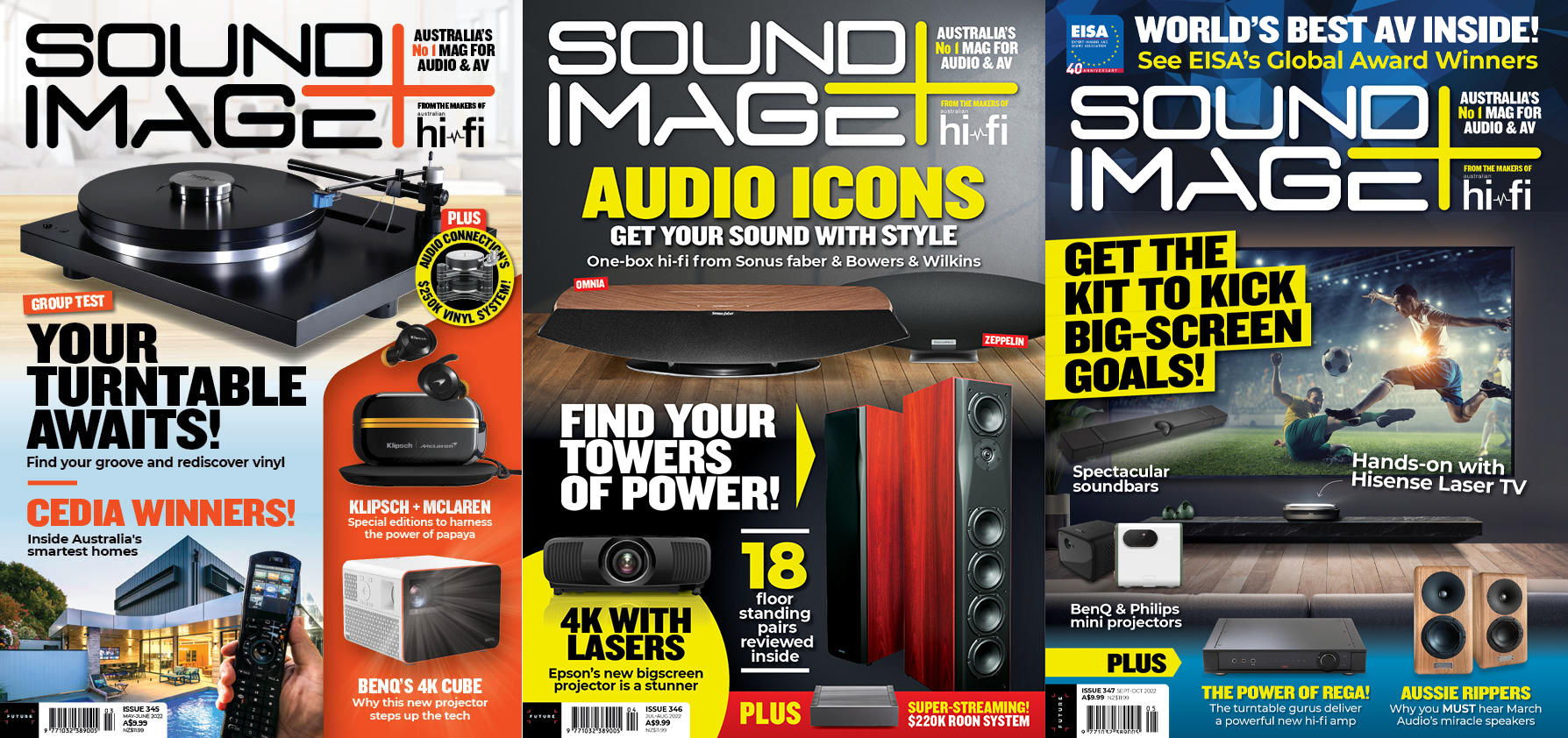
This review originally appeared in Sound+Image magazine, Australian sister publication to What Hi-Fi?. Click here for more information on Sound+Image, including digital editions and details on how you can subscribe.
Read What Hi-Fi?'s global, star-rated Marantz Cinema 30 review.
Since a recent reinvention as the 'Cinema' series, the numbering of the AV receiver range from Marantz has become a convergent sequence. It starts up high, with the ‘slimline’ Cinema ‘70s’ model down at $2000, then rises through the increasingly less slimline Cinemas 60, 50 and 40, rising now to this new and definitely full-fat Cinema 30.
These ever-lower numbers indicate ever-higher models, and those models have been arriving on the market roughly in order of complexity. And with only two lower/higher slots left before they zero out, the Japanese AV team must be trying to cram it all in before they run out of numbers.
But in fact the ‘10’ was taken early, by the AV10 processor and AMP10 (but 16-channel) amplifier, the toppermost (but separates) solution in Marantz’s multichannel world. And there’s no word of a Cinema 20, even of a roadmap, we gather. The Cinema 30 is the ‘replacement’ for the previous range-topping SR8015 integrated AV receiver, and we note that Marantz refers to this Cinema 30 as being a ‘Reference’ receiver, something only generally applied to its top of the range.
They say 'receiver', and we'll say 'receiver', but under old-school definitions this is really an amplifier, because it doesn't receive radio through the air using an antenna. (Although the documentation on the Australian website currently says that it does, appearing to relate to the US model.) But in any case, there's web radio available via the internet anyway, so isn't that simply a 21st-century receiver?
However you pigeon-hole it, it seems safe to assume that this latest Cinema 30 is to be the highest all-round integrated entertainment machine on offer from Marantz in its current cycle, short of breaking things into two boxes and going AV10 and AMP 10. But those are £12,400 ($14,000 / A$25,600) the pair – and the amp uses Class-D modules for its 16 channels of power, rather than the more traditional (and for some folks also preferred) Class-AB circuits that are used here.
With the Cinema 30 fresh to market, we looked forward to all the latest tweaks, together with its vast selection of inputs and abilities. Let’s take a deep breath and dive aboard.

Power, and plenty of it
Interestingly, in a market often defined by power and channel count, Marantz calls the Cinema 30 “the most refined AVR Marantz has created”. But of course refinement is what we want, in home cinema as much as in stereo operation, remembering that this vasty tower of power will be servicing us for delicate music as much as space-ship explosions, and that it must handle the intricacies of dialogue delivery, not to mention the processing that splits a single Dolby Atmos data package into all those separate channels.
The latest hi-fi, home cinema and tech news, reviews, buying advice and deals, direct to your inbox.
In the old days of surround, every channel of sound arrived separately within a soundtrack, each getting a channel of power to push it into the room. That is no longer the case. Dolby Atmos changed the game (along with other immersive formats, should you ever now find any, for they are utterly dominated by the double-D). Atmos delivers a stream which is broken into individual channels only when it reaches the receiver’s own processing. That allows a bespoke Atmos output to match exactly the channels you have available, whether that be stereo, mono, or the glorious spread of 11 to 13 channels available here.
We say “11 to 13” because there are 11 channels of power, but with 13-channel processing onboard, so there are two additional pre-outs which could be used to expand on the 11 channels of power. Add the ability to supply four subwoofers independently with genuinely variegated bass content, and you can run a system of 13.4 channels by adding power for those two pre-outs, or more likely for most users, 11.4 channels using the receiver alone.
So this might be, say, a 7.2.4 home cinema, using seven floor channels of conventional surround, four ceiling speakers to deliver the height element of Atmos signals, and perhaps two subwoofers of the available four.
Or, as we were to listen to it, in 5.3.6, with five channels of front and surround from Bowers & Wilkins 800 Series architectural speakers, a generous six ceiling-mounted height speakers, plus three massive (really massive, 15-inch) Definitive Technology Descend subwoofers, all gathered to entertainment us in the Sydney cinema room of Masimo Consumer (formerly Sound United, formerly Bowers & Wilkins Australia, etc).
On the Cinema 30, all the speaker outputs are assignable, so you can use the channels for whatever configuration of system you prefer, and the Marantz will process accordingly. You might need only five surround channels and two for height, leaving channels of power free to do other things, such as drive a whole second room of entertainment independently in stereo – there’s an HDMI out for an independent video stream as well. There are even pre-outs for a third zone.
You could use spare amp channels to biamplify your main front speakers, driving bass and treble separately, and so with additional power for stereo music as well as soundtracks.
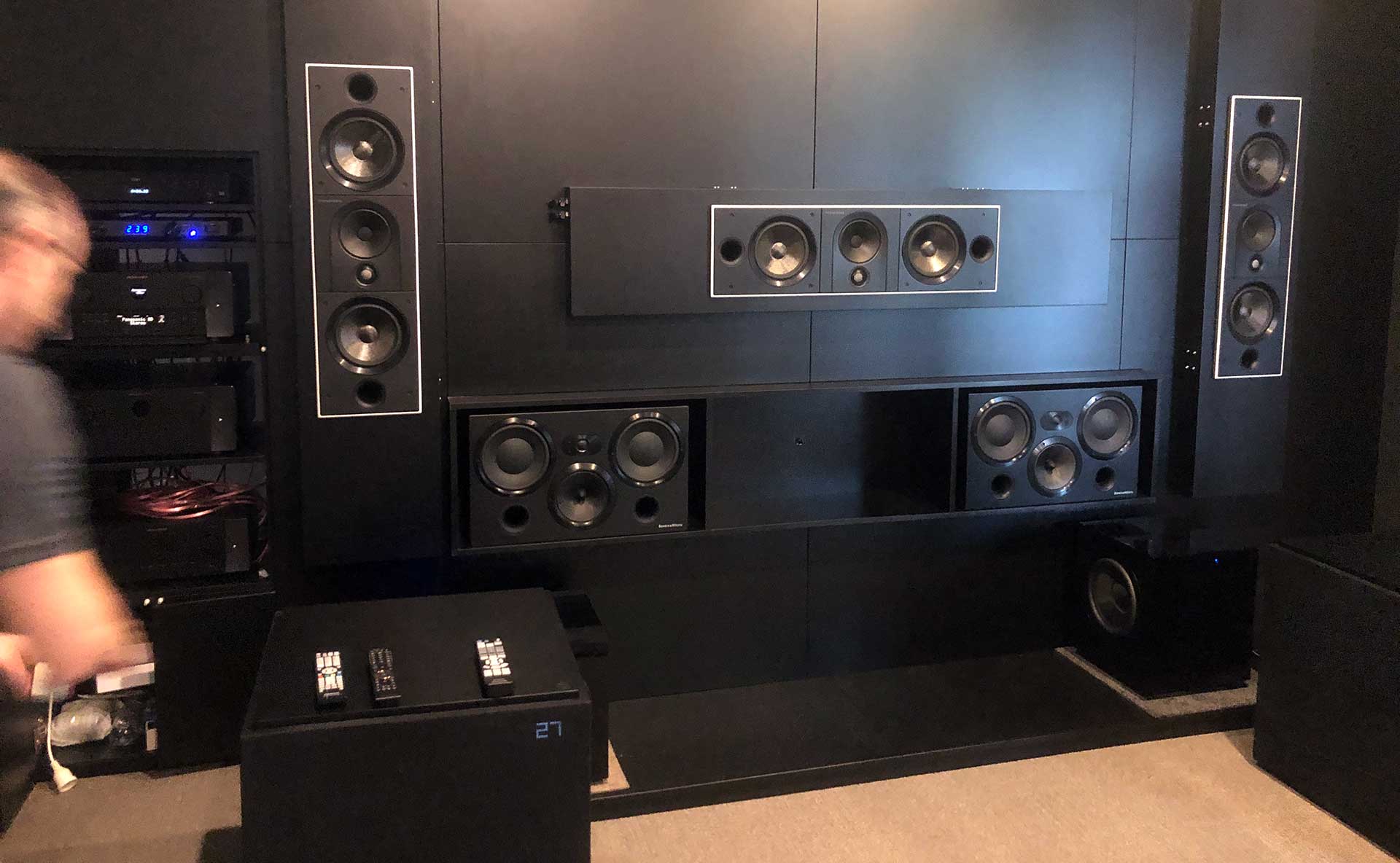
Once you’ve decided how to use your power, how easy is it to tell the Cinema 30 what to do? Here we were well-prepared by having already spent time in our listening rooms with two of the lower receivers in the series, Cinemas 40 and 60. So we knew not to spend too much time studying the immense product manual, which can be confusing, both because Marantz doesn’t follow the conventional way of describing systems (so instead of 5.1.4 it will say just 9.1, which is more ambiguous); the manual also bounces you around between sections until you’re thoroughly befuddled.
No, we’ve learnt before just to get on with it, because Marantz has an excellent wizard built into the receiver itself, which uses your TV screen to walk you through everything, including wiring everything up. Obviously you’ll need to connect the receiver to the TV and to power them up to get this far, but we hope even a newbie might get there OK, if they don’t panic at the sheer number of cables you’ll be preparing to insert into those closely-spaced speaker terminals while trying not to invert or short anything as you channel your power to the correct locations.
How much power? That depends where you look and also how you measure: the headline spec used on Marantz’s websites is 140W per channel, so it’s pleasing to find that is a fairly hi-fi spec: it’s measured with only two channels driven, but full frequency range (20Hz-20kHz) into 8 ohms allowing for a maximum 0.05% THD+N distortion. But relax the parameters to one channel, six ohms and a whacking 10% distortion, and you can call it 230W a channel. This is why comparing watts between manufacturers can be a tricky exercise. You can, however, more reliably compare within a brand, noting here that power levels drop with channel count all down the range – the Cinema 50 has 9 x 110W, the Cinema 70s has 7 x 50W. So here you’re not only getting more channels, you’re getting more power per channel.
And it’s solid Marantz power technology, including HDAM-SA2 amplifier modules. What’s an HDAM? The original Hyper Dynamic Amplifier Module arrived in 1992 inside the PM-99SE integrated amplifier, and they are basically just an amplifier circuit of discrete components carefully arranged and put in a box, evolving over the years in search of higher slew rates and higher signal-to-noise.
The HDAM-SA variant arrived in 2002, and was a unity-gain buffer design for preamplification use with current feedback loop amplifiers; we may perhaps presume the HDAM-SA2 modules here, 20 years on, play a similar role, given that the company says the HDAMs "ensure the characteristic warmth and musicality expected from any Marantz audio product", while the power devices in the Cinema 30 are current-doubling Darlington transistors (type BL15N15A).

Inputs & processing
Anyone in the know could identify the Cinema 30 from a distance as being a Marantz product, not because of the new company livery with its trippy swirly fascia patterns, but because it has that circular ‘porthole’ on the front, a defining design characteristic with which the company persists even though it’s clearly a fairly ridiculous place to put a detailed LED display. ‘See the TV’ is its most sensible message, early on during set-up, as if admitting its own inadequacy for displaying information.
This admission gets a doubling down by Marantz putting a second far larger display (they call it a ‘sub-display’) on the front panel, hidden under an old-style front flap, something missing from the lowest models in the range.
But we must say that this flap keeps the Cinema 30 looking much neater than the flap-less Cinema 60 we tested about a year ago. It hides an assortment of buttonry and socketry, including menu controls, zone source selection, the ever-wonderful ‘Pure Direct’ button, the don’t-touch-it M-DAX button, a handy spare USB-A slot, and the mike socket for the supplied room-calibration microphone.
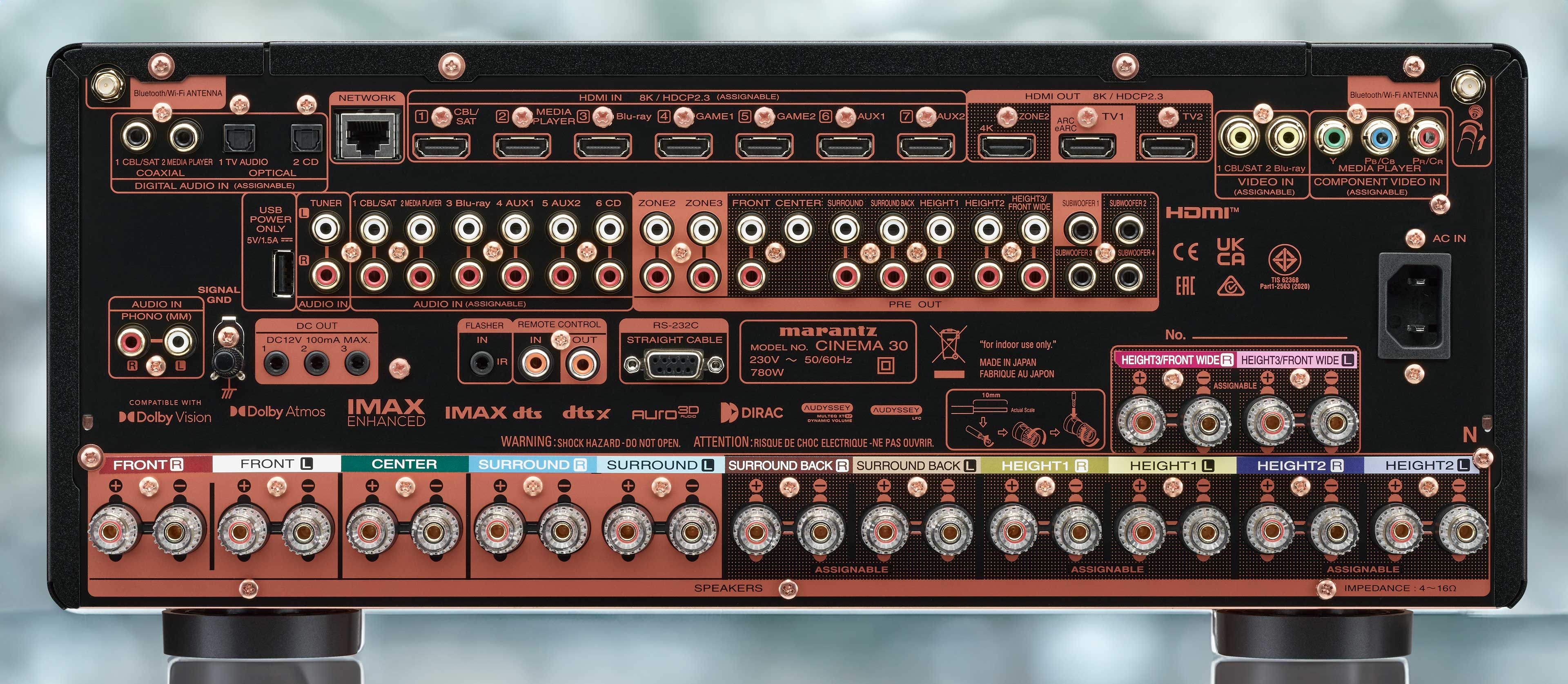
Meanwhile the back panel is enough to warm the cockles of an AV aficionado, or alternately ignite technofear in a newbie, though we imagine most such owners would elicit at least friendly if not actual dealer assistance before setting up a complex entity like this, making all the connections and allocating all the socketry. But as noted, if facing such a task alone, the set-up wizard is a fairly faithful friend in getting you through the whole process.
So sockets a-plenty. It has seven HDMI inputs, or eight if you count the middle of three outputs, usefully highlighted, since this carries HDMI eARC (Audio Return Channel, the ‘enhanced’ Atmos-compatible version) to play audio back from the connected TV.
All HDMI inputs and the three outputs are marked as 8K compatible, so you’re future-proofed for the next generation of video, if it ever comes.
The receiver’s audio circuits can decode and handle Dolby Atmos, DTS:X, IMAX Enhanced (Atmos or DTS:X), and Auro 3D, also having the Atmos and DTS upscalers which can expand lesser content across your full speaker set, should you approve the manner in which it does so.
There are plenty of separate stereo and digital audio inputs, of course, nearly all of which can be assigned to the video of any given HDMI input, or to the three legacy video inputs: two composite and one component. Some socket types aren’t extravagantly provided: only two optical and two coaxial digital inputs, for example, just one USB-A and that on the front panel (the rear one is only for power), and we might consider the lack of USB-B to be a curious and disappointing omission.
The only input you can’t tie to a video input is the moving-magnet turntable phono input. But there are six line-level inputs on RCA sockets, and enormous future flexibility is gifted by a complete set of pre-out sockets, allowing you to use external amplification to upgrade any or all channels – more, in fact, because there are 13, given those extra two channels of processing.
There’s Ethernet and Wi-Fi to get you networked; there are separate antenna inputs (and supplied antennas) for FM, AM and Wi-Fi/Bluetooth. The inward Bluetooth connection appears to support only the base-level SBC codec, so we’d suggest you find a different way to stream, such as HEOS playback from your device.
Because yes there’s the huge bonus of HEOS here, a full wireless and multiroom platform compatible with any number of other Denon, Marantz and HEOS-branded products. This gives app-controlled access to streaming music services, podcasts and internet radio, as well as general remote control of the Cinema 30, and the ability to stream Bluetooth out to headphones, and to share any input except AirPlay with any other HEOS product in the home.
As for the speaker connections on the Cinema 30, there are more pairs of binding posts than there are amplification channels available. The main group is labelled for 7.x.4 (where the ‘x’ is the number of subwoofers, up to four). But additional sockets allow you to connect two different speaker scenarios at the same time, and then switch between them.
Let's calibrate!
Room calibration is available, and some would say essential as the channel count rises this high. Calibration can rankle if you’ve spent time perfecting your room, but few are the rooms which are genuinely perfect, and many are the resonant modes that room correction can root out and adjust.
It’s getting a bit out of hand here, perhaps, with five upgrades available above the included Audyssey XT32: there's a US$20 Audyssey app which allows you to adjust the curve, or a US$200 Audyssey MultEQ-X licence, for which you also might like to buy the dedicated Audyssey ACM1-X microphone at $176 on Amazon. But the Cinema 30 can also respond to the machinations of Dirac – either Dirac Live Limited Bandwidth or Dirac Live Full Bandwidth, alongside Dirac Bass Management.
The Cinema 30 we were listening to was calibrated using the included Audyssey XT32 and packaged microphone; this requires making measurements at some eight different positions to calibrate the room for multiple listening positions (we’re rather selfish and would prefer to calibrate to just one seat, but the option is not available).
We confess to finding calibration a wildly tedious process, though we always try it, so we were delighted when Adam Prangell of the local Marantz team offered to do that for us prior to arrival. We had headed to Masimo Manor in leafy Chatswood for this listening session primarily because our own listening room is wired for 5.1.2; it has previously hosted both the Cinema 60 and Cinema 40 for full testing, but the room's channel count is too low to take the Marantz 30 to its limits. So in Masimo's cavernous Chatswood chambers we met with Adam Prangell, who was ready to introduce us to, and then leave us alone with, the Cinema 30.

Listening sessions
We warmed up our ears with a bit of stereo and surround listening. Adam had the Audyssey correction already completed and saved to the first of two available speaker scenario presets (rather more of these might be useful for variations), so we were able to easily switch to the raw sound for comparison. We quickly decided that the Audyssey had here done its job well, in particular with regards to the bass management of the three individually-fed subwoofers.
We did enter the speaker set-up menus, however (see screen grab two pics above); we’re familiar with these from our previous reviews of the Cinema 40 and Cinema 60. Here we entered the menus and tweaked the Audyssey speaker levels just a little to hotten the rears and height to achieve a fully in-your-head sound for two very different test discs: the opening of Mad Max: Fury Road and the high-res surround mixes of Peter Gabriel’s ‘Play’ DVD. Both of these have a voice track which comes at equal level from all sides, so if you tweak until the voice is in your head, things are about right. (If it’s clearly centralised then you’ve got impressive tonal matching as well.)
Movies first. For our money, movies are relatively easy to deliver compared with music; it’s as much about the ability to deliver shifts of power as it is for tonal accuracy, which is hard to judge on a soundtrack unless you know your references well. We do know the intro of Baz Luhrmann’s Elvis well from our own 5.1.2 system, so were pleased to hear it upscaled to the higher speaker count here by the Marantz with an even wilder exuberance of surround elements, yet locked centrally with solid LCR and dialogue legibility. Bowed strings filled the room as the intensity ratcheted up the ‘Zarathustra’ build to his Vegas show snippet of An American Trilogy... it’s a symphony of surround, this intro sequence from the UHD Blu-ray, and the Cinema 30 threw every element into the required corner.
On to the marvellous mix of atmospherics and action in Alita: Battle Angel (UHD Blu-ray again), where the monumental subwoofer rumble in the opening minute charged the room fully with bass. The busy streetscape in scene 4 showed the Cinema 30’s ability to simultaneously deliver atmosphere – both an ongoing the street rumble and a series of pocket effects in the rears – while having plenty in reserve to blast out the dynamics and depth on the arrival of the Centurion police robot.

A big early tick for the movies, then. But music is perhaps the greater challenge for a surround system, requiring accuracy as well as allure.
We loaded one of producer Morten Lindberg’s latest masterworks on 2L Records, ‘An Old Hall Ladymass’, recorded which blew us away on first hearing as you can read here. Lindberg’s multiGrammy-nominated releases offer high-res stereo, Atmos to 48kHz and interestingly, Auro-3D to 96kHz. There’s not much Auro-3D source material available, nor too many receivers that include it as standard (though more of them recently, as a 'NewAuro' brand is rising).
But the Marantz 30 is one that does include Auro-3D as standard.
We had only previous heard the Atmos version. Morten’s recordings are made using a high multichannel mike array, and they are not merely immersive but experiential. When your system is right they knit your speakers into the high vaulted cathedrals in which they were recorded, and more importantly you are impeccably placed in the middle of the performance. This recording features some particularly divine vocals but also an extraordinary portable organetto courtesy of Catalina Vicens, with which and with whom we have fallen quite in love. We played it through the Cinema 30 in Atmos, It was a joy to hear it in an even bigger room, on more expensive kit, though the sense of space was the same, equally thrilling: the organ tone and the sense of high acoustic on Stella celi was outstanding.
We switched to the Auro-3D option on this disc, but the Marantz didn’t recognise it, outputting something less. We later asked Adam Prangell back in and he solved it; you have to use the ‘Movie’ sound mode button and select Auro-3D from the onscreen menu – and then, yes, the additional resolution of the Auro-3D version was instantly obvious in a still greater sense of space delivered from the higher level cues, a real sign of the ability of the Marantz (and the whole system) to discern and deliver such delicacy. Almost sad, really, as we may never again hear it like this.
Mr Prangell also alerted us to a ‘CI’ engineering mode which can be accessed by holding down the ‘info’ key for five seconds to display the Cinema 30’s IP address, which you then type into a browser on your network. The secret menus there are passworded to protect against those who don’t know what they’re doing – but if you do, we gather the default password is ‘cinema30’.
More discs next: it might seem something of a downgrade then to start pulling out ye olde DVDs – but we have a DVD music collection which is loaded with hidden high-res surround mixes, many in high-res DTS 5.1. Our favourite, hands down, is The Beatles ‘Love’ (it sells as a CD/DVD pack for about A$30, lots out there). Of all Giles Martin’s surround remixes, this 5.1 set is still the most thrilling surround release: we started with Eleanor Rigby, where McCartney and string quartet sit up front, extra cellos to the rears, filling the room.
But we were finding, to our surprise, that the LCR Bowers & Wilkins speakers weren’t giving music the neutrality or sweetness required; they were coming over rather brash. Thankfully we remembered to try the ‘Pure Direct’ button on the Marantz remote (it shuttles between normal, merely ‘Direct’ and ‘Pure Direct’); the switch briefly interrupted things before fixing that brashness entirely, just in time for a reference level blast of the brilliant and bonkers I Am The Walrus mix on this disc.
The ‘original’ of I Am The Walrus has recently been freshly rendered into Atmos for the ‘Blue’ compilation album re-release, so we switched over to Apple Music on the Apple TV we’d brought with us… the immersive Atmos mix certainly sounded nicely spread across the system, but it lacked the sheer exuberance and freedom of the ‘Love’ DVD DTS high-res version.
Should you happen to be a Yes fan with a surround system, we heartily recommend Steven Wilson’s 5.1 mixes, especially in DTS-Master Audio. We loaded ‘Close To The Edge’ and – again with Pure Direct engaged for best results – played And You & I at something probably beyond reference level, and it was stunning in both dynamics and clarity. Being merely 5.1, we could press the Marantz’s Music mode button to invoke a variety of upscaling modes – we thought ‘DTS + Virtual X’ might be appropriate here to lift the sound into all speakers. Effective it was, but not pure; things were far more precisely positioned and crisp in the native high-res 5.1.
Our preference for Pure DIrect presents one dilemma – perhaps we weren't so keen on the Audyssey correction, as we later established that Pure Direct mode would have been turning that off. So was it the correction removal or other internal cleansing that made Pure Direct so good? With no way to invoke it but leave Audyssey on, there was no way to isolate exactly where the goodness and the brashness were coming from.

What we didn’t test in detail during this listening visit was the entire HEOS section, the multiple zoning, and anything to do with video quality.
But as with the set-up and calibration, we have been through all those in detail in our reviews of the Cinemas 40 and 60 previously and so can speak to their effectiveness; aside from zone count and the power behind it all, there’s little variation here with the higher model.
In terms of music access, of course HEOS brings all the streaming services, internet radio, file sharing from NAS drives, radio, internet radio – a huge wealth of entertainment so that you might not need to plug in any music sources… unless you want surround music, as the HEOS implementation doesn’t deliver Tidal’s Atmos tracks, nor is there support in HEOS, of course, for Apple Music with its large Atmos catalogue.
Which is why we had taken the Apple TV with us. We used it to try the new Atmos mixes of ‘Band On The Run’, streaming from Apple Music (oddly missing from Tidal)… it was OK, but we were perhaps adjusting to the quality of streaming after the immaculate immersion we’d been enjoying from discs playing in the Panasonic Ultra HD Blu-ray player of this set-up. For surround music, the discs easily beat the streaming services for clarity of delivery, but the streaming services have the ever-expanding Atmos catalogue of new and remastered immersive music.
Once we’d settled into the streaming, we ran through some modern Atmos mixes, rather than re-mixed classics. Olivia Rodrigo’s awesome bad idea right? was a bit disappointing, not using a lot of surround spread, though the Marantz still gave it a thrilling kick-arse energy to match its own exuberance.
Hot Chip’s Hard To Be Funky, by contrast, is an Atmos delight, blippy and clicky all around the place, and warming those giant DefTech subwoofers through nicely as it filled the full space with groove.
Boygenius’ $20 is another immersive goodie, especially the closing section, which wafted over us with waves of delight. AJR splits their The Dumb Song beautifully into front and rear sections, leaving you centred in exactly the ‘world of your own’ that immersive music promotes. If you have a real surround system and haven’t yet got into surround music, man, get streaming, or get some discs, and get cranking.
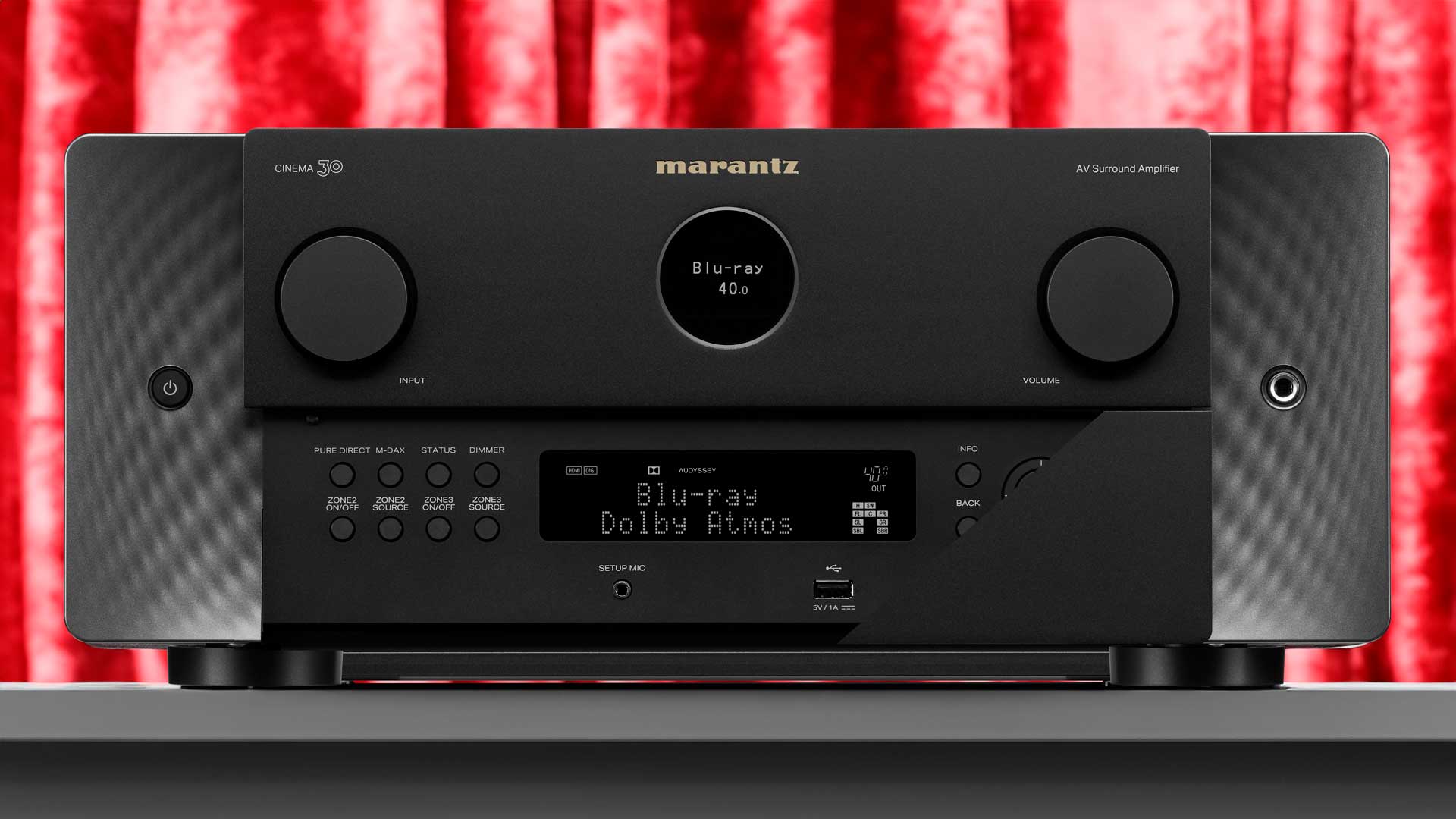
Verdict
It’s the top of the heap for Marantz’s integrated AV receivers, the latest range-topper in a long line of renowned AV products, providing both more channels and more power than any lower model, along with pretty much exhaustive socketry (bar the missing USB-B), full streaming and more than full multiroom (via any of HEOS, AirPlay or extra zones).
It’s solid and pretty attractive for such a beast, and one of its most recommendable traits is that while its full manual is something of a nightmare, it has an on-TV wizard which walks you through set-up beautifully, making this most complicated of audio-visual products remarkably easy to understand.
The Cinema 30 is a range-topper for good reason, backed by decades of leadership in amplification and AV receivers. We reckon you’ll get everything you could hope for here, including the essential fundamental sound quality, and with plenty of little surprise bonuses hidden away.

Jez is the Editor of Sound+Image magazine, having inhabited that role since 2006, more or less a lustrum after departing his UK homeland to adopt an additional nationality under the more favourable climes and skies of Australia. Prior to his desertion he was Editor of the UK's Stuff magazine, and before that Editor of What Hi-Fi? magazine, and before that of the erstwhile Audiophile magazine and of Electronics Today International. He makes music as well as enjoying it, is alarmingly wedded to the notion that Led Zeppelin remains the highest point of rock'n'roll yet attained, though remains willing to assess modern pretenders. He lives in a modest shack on Sydney's Northern Beaches with his Canadian wife Deanna, a rescue greyhound called Jewels, and an assortment of changing wildlife under care. If you're seeking his articles by clicking this profile, you'll see far more of them by switching to the Australian version of WHF.

